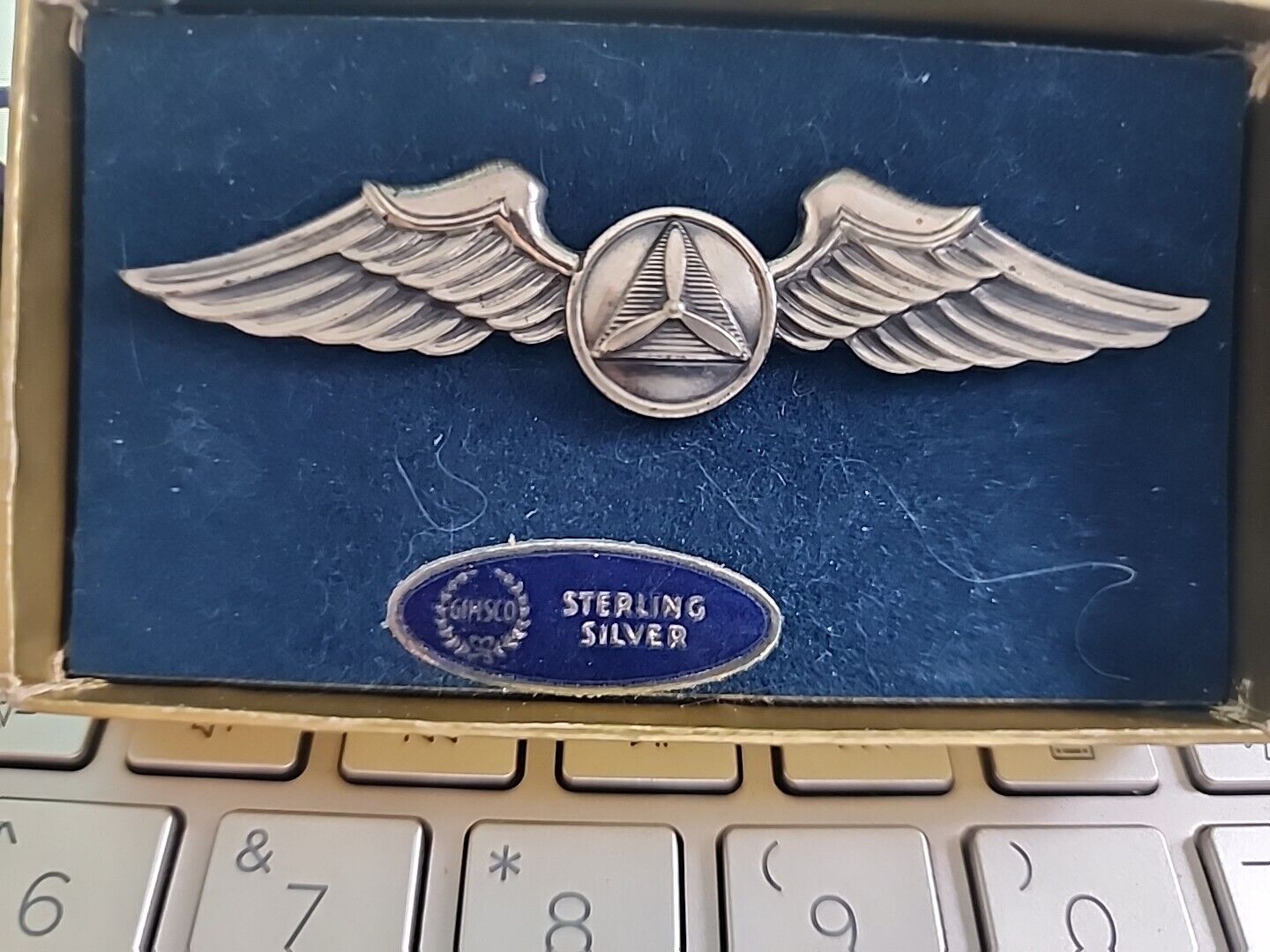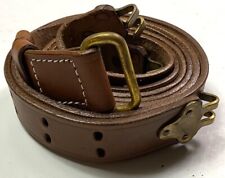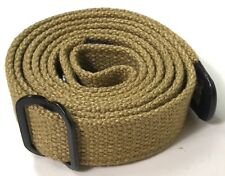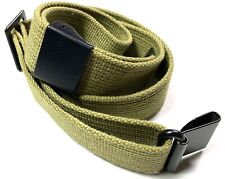WWII US CAP Wings Pin Back, Sterling-REAL THING -RARE - NAVY VET OWNED For Sale

When you click on links to various merchants on this site and make a purchase, this can result in this site earning a commission. Affiliate programs and affiliations include, but are not limited to, the eBay Partner Network.
WWII US CAP Wings Pin Back, Sterling-REAL THING -RARE - NAVY VET OWNED:
$49.99
Here is a very nice Vintage Sterling Silver World War II United States C.A.P. Wings Pinback Pin, 3 1/4 inches wide, by Gemsco, New York, in PERFECT condition, World War II[edit]The Subchasers of CAP Coastal Base3,Lantana, FloridaWith the approval of the Army Air Forces, Director La Guardia formalized the creation of Civil Air Patrol withAdministrative Order 9, signed on 1 December 1941 and published 8 December 1941. This order outlined Civil Air Patrol\'s organization and named its first national commander as Major GeneralJohn F. Curry. Wilson was officially made the executive officer of the new organization. Additionally, Colonel Harry H. Blee was appointed the new operations director.[1]
The very fear that sparked the Civil Air Patrol \"movement\"– thatgeneral aviationwould be halted– became a reality when theImperial Japanese NavyattackedPearl Harboron 7 December 1941. On 8 December 1941, all civil aircraft, with the exception of airliners, were grounded. This ban was lifted two days later (with the exception of the entireUnited States West Coast) and things went more or less back to normal.
Earle E. Johnson took notice of the lack of security at general aviationairportsdespite the attack on Pearl Harbor. Seeing the potential for light aircraft to be used by saboteurs, Johnson took it upon himself to prove how vulnerable the nation was. Johnson took off in his own aircraft from his farm airstrip nearCleveland, Ohio, taking three smallsandbagswith him. Flying at 500 feet (150m), Johnson dropped a sandbag on each of three war plants and then returned to his airstrip. The next morning he notified the factory owners that he had \"bombed\" their facilities. The Civil Aeronautics Administration (CAA) apparently got Johnson\'s message and grounded all civil aviation until better security measures could be taken. Not surprisingly, Civil Air Patrol\'s initial membership increased along with the new security.[2]
With America\'s entrance intoWorld War II, GermanU-boatsbegan tooperate along the East Coast. Their operations were very effective, sinking a total of 204 vessels by September 1942. Civil Air Patrol\'s top leaders requested that the War Department give them the authority to directly combat the U-boat threat. The request was initially opposed, for the CAP was still a young and inexperienced organization. However, with the alarming numbers of ships being sunk by the U-boats, the War Department finally agreed to give CAP a chance.
On 5 March 1942, under the leadership of the newly promotedNational CommanderJohnson (the same Johnson that had \"bombed\" the factories with sandbags), Civil Air Patrol was given authority to operate a coastal patrol at two locations along the East Coast:Atlantic City, New Jersey, andRehoboth Beach, Delaware. They were given a time frame of 90 days to prove their worth. The CAP\'s performance was outstanding, and before the 90-day period was over, the coastal patrol operations were authorized to expand in both duration and territory.[3]By the end of the war, CAP pilots had flown over 500,000 mission hours. However, more than 90 aircraft were lost, and between 59 and 64 CAP pilots were killed, including 26 who were lost while on coastal patrol.[4][5]
Coastal Patrol[edit]Originally under 1 Air Support Command, CAP was placed under1 Bomber Command19 August 1942.[6]At its height, Civil Air Patrol Coastal Patrol operated 21 coastal bases in 13 states along theEastern Seaboardand theGulf of Mexico.[7]The Coastal Patrol was originally meant to be unarmed and strictlyreconnaissance. The air crews of the patrol aircraft were to keep in touch with their bases and notify the Army Air Forces and Navy in the area when a U-boat was sighted, and to remain in the area until relieved. This policy was reviewed, however, when Civil Air Patrol encountered aturkey shootopportunity. In May 1942, a CAP crew consisting of pilot Thomas Manning and observer Marshall \"Doc\" Rinker were flying a coastal patrol mission offCape Canaveralwhen they spotted a German U-boat. The U-boat crew also spotted the aircraft, but not knowing that it was unarmed, attempted to flee. The U-boat became stuck on asandbar, and consequently became an easy target.
Rinker and Manning radioed to mission base the opportunity and circled the U-boat for more than half an hour. Unfortunately, by the time that Army Air Forcebomberscame to destroy the U-boat, the vessel had dislodged itself and had escaped to deep waters. As a result of this incident, CAP aircraft were authorized to be fitted withbombsanddepth charges. Some of CAP\'s larger aircraft had the capability of carrying a single 300-pound (140kg) depth charge, however, most light aircraft could only carry a 100-pound (50kg) bomb. In some cases, the bomb\'s flight fins had to be partially removed so they would be able to fit underneath the wing of a light aircraft.[5]
One squadron\'s insignia of the time was a cartoon drawing of a small plane sweating and straining to carry a large bomb. This insignia became popular throughout CAP.
The CAP\'s alleged first kill was claimed by one of the larger aircraft on 11 July 1942. TheGrumman G-44 Widgeon, armed with two depth charges and crewed by Captain Johnny Haggins and Major Wynant Farr, was scrambled when another CAP patrol radioed that they had encountered an enemy submarine but were returning to base due to low fuel. After scanning the area, Farr spotted the U-boat cruising beneath the surface of the waves. Unable to accurately determine the depth of the vessel, Haggins and Ferr radioed the situation back to base and followed the enemy in hopes that it would rise toperiscope depth. For three hours, the crew shadowed the submarine. Just as Haggins was about to return to base, the U-boat rose to periscope depth, and Haggins swung the aircraft around, aligned with the submarine and dove to 100 feet (30m). Farr released one of the two depth charges, blowing the submarine\'s front out of the water. As it left anoil slick, Farr made a second pass and released the other charge. Debris appeared on the ocean\'s surface, seemingly confirming the U-boat\'s demise and CAP\'s first kill.[8]CAP\'s Coastal Patrol operated for about 18 months (from 5 March 1942 to 31 August 1943) before being officially retired. During this time, the Coastal Patrol reported sighting 173 U-boats and dropping 82 bombs or depth charges. Overall, the Coastal Patrol flew 86,685 missions, logging over 244,600 hours. Coastal Patrol aircraft reported 91 ships in distress and played a key role in rescuing 363 survivors of U-boat attacks. 17 floating mines were reported and 5,684 convoy missions were flown for the Navy.[9][10]
Border Patrol[edit]Between July 1942 and April 1944, the Civil Air Patrol Southern Liaison Patrol was given the task of patrolling the border betweenBrownsville,Texas, andDouglas,Arizona. The Southern Liaison Patrol logged approximately 30,000 flight hours and patrolled roughly 1,000 miles (1,600km) of the land separating theUnited StatesandMexico. Southern Liaison Patrol tasks included looking for indications ofspyorsaboteuractivity and were similar to counterdrug missions executed by Civil Air Patrol today. Aircraft piloted by the Southern Liaison Patrol often flew low enough to read the license plates on suspicious automobiles traveling in the patrol region.
During its time of operation the Southern Liaison Patrol, more commonly known as the \"CAP Border Patrol\", reported almost 7,000 out-of-the-ordinary activities and 176 suspicious aircraft\' descriptions and direction. During the entire operating period, only two members lost their lives. Considering the fact that the Border Patrol was one of the most dangerous missions CAP flew (along with Coastal Patrol), this is an exceptionally low number.
Target towing[edit]In March 1942, CAP aircraft began towing targets for air-to-air (fighters) and ground-to-air (anti-aircraft batteries) gunnery practice. Targets would be trailed behind the aircraft (similar to the way an aircraft trails a banner) to simulate strafing attacks. CAP aircraft would also climb to various altitudes and would trail two targets for heavy AA guns to use for practice. Although uncommon, an antiaircraft round would occasionally hit the aircraft. Surprisingly, no deaths resulted from errant shots.
Similarly, CAP aircraft also flew night missions to provide tracking practice for the crews of searchlights and radar units. These missions were dangerous in the sense that the pilot ran the risk of accidentally looking into the glare of a searchlight while performingevasive maneuvers, which would blind and disorient him. Such was the case of Captain Raoul Souliere, who lost his life after he went into a steep dive; witnesses surmised that he looked into the glare of a spotlight that had locked on to him, became disoriented, and did not realize he was in a dive.
Despite the dangerous nature of these missions, fatalities and accidents were rare. CAP flew target missions for three years with 7 member fatalities, 5 serious injuries and 23 aircraft lost. A total of 20,593 towing and tracking missions were flown.[11]
Search and Rescue operations (SAR)[edit]During the period between 1 January 1942 and 1 January 1946, Civil Air Patrol pilots flew over 24,000 hours of federal- and military-assignedsearch and rescuemissions in addition to thousands of hours of non-assigned SAR missions. These missions were a huge success, and in one particular week during February 1945, CAP SAR air crews found seven missing Army and Navy aircraft.
Civil Air Patrol had several decisive advantages over theArmy Air Forcesin terms of SAR ability. First, because CAP was using civilian aircraft, they could fly lower and slower than the aircraft of the AAF. Second, unlike AAF pilots, CAP pilots tended to be local citizens and therefore knew the terrain much better. Third, CAP utilized ground teams which would travel to the suspected crash site (often by foot, although some wings had other ways of reaching a wreckage).
Courier service and cargo transportation[edit]In the spring of 1942, the Pennsylvania Wing conducted a 30-day experiment with the intention of convincing the AAF that they were capable of flying cargo missions for the nation. The Pennsylvania Wing transported Army cargo as far as Georgia, and top Army officials were impressed. The War Department gave CAP permission to conduct courier and cargo service for the military.
Although not generally remembered as one of CAP\'s \"glamorous\" jobs, cargo and courier transportation was an important job for the organization. From 1942 to 1944, Civil Air Patrol moved around 1,750short tons(1,590t) of mail and cargo and hundreds of military passengers.
Pilot training and the cadet program[edit]In October 1942, CAP planned a program to recruit and train youth with an emphasis on flight training. The CAP cadets assisted with operational tasks and began training towards becoming licensed pilots. Cadets were not exempt from beingconscripted; however, the military atmosphere and general setting around them would provide an advantage to cadets who were subsequently called into service. To become a cadet, one had to be between the ages of 15 and 17, and be sponsored by a CAP member of the same gender. The cadet program called for physical fitness, completion of the first two years of high school and satisfactory grades. It was open only to native-born American citizens of parents who had been citizens of the United States for at least ten years. These restrictions were intentionally imposed to hold down membership levels until a solid foundation could be established.
Perhaps the most astonishing fact of the cadet program\'s 20,000-plus initial membership was thelackof cost; it cost theOffice of Civilian Defenseless than US$200 to get the program underway, and this was to cover administrative costs.[12]
Other wartime activities[edit]CAP pilots were called on to provide a variety of missions that were not necessarily combat-related but still of direct benefit to the country. Some of the most notable of these missions were: flying blood bank mercy missions for theAmerican Red Crossand other similar agencies; forest fire patrol and arson reporting; mock raids to test blackout practices and air raid warning systems; supportingwar bonddrives; and assisting in salvage collection drives. In the Northwestern states, Civil Air Patrol members, armed with shotguns, flew patrols hoping to spotJapanese balloon bombs.
Perhaps the most curious job for CAP was \"wolf patrol\". In the southwesternUnited States, the native wolf population had been disrupting ranching operations. One rancher alone lost over 1,000 head of cattle due to wolf predation. This represented a huge monetary loss to ranchers and an added restriction to the already low supply of beef due to wartime rationing. By the winter of 1944,Texasrancherslobbied the Texan governor to enlist the aid of Civil Air Patrol to control the wolf populations. CAP pilots, armed withfirearms, flew overwolf territoryand thinned the population to lower levels.
CAP even had its own airbase during the war. A Civil Aeronautics Administration (CAA) auxiliary landing field, northwest ofBaker,California, was given to Civil Air Patrol. Used primarily for training, Silver Lake boasted a hangar, barracks, mess hall and even a swimming pool and bath house.
Results of wartime activities[edit]J-3 aircraft with CAP markings on display at theNational Museum of the United States Air ForceCivil Air Patrol\'s success with the cadet program, along with its impressive wartime record, led theWar Departmentto create a permanent place for it in the department. On 29 April 1943, by order of PresidentFranklin D. Roosevelt, the command of Civil Air Patrol was transferred from theOffice of Civilian Defenseto the War Department and given status as the auxiliary to the Army Air Forces. On 4 March 1943, the War Department issuedMemorandum W95-12-43, which assigned the AAF the responsibility for supervising and directing operations of the CAP.
One of the direct outcomes of this transfer was the loaning of 288Piper L-4 \"Grasshopper\"aircraft from the AAF to the CAP. These aircraft were used in the cadet recruiting program. By 1945 there was an oversupply of cadets and CAP took over the responsibility of administering cadet mental screening test

Related Items:
WWII US SQUAD BROWNING BAR CARRY SLING-OILED
$31.96
WWII US GREASE GUN RIFLE CARRY SLING-KHAKI
$19.96
WWII US M1 GARAND RIFLE CANVAS RIFLE CARRY SLING-OD#3
$23.96



